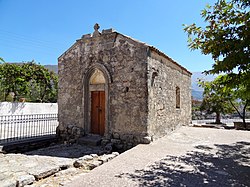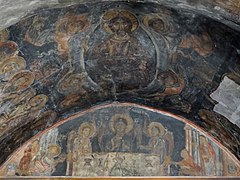Naos Panagias (Thronos)
| Naos Panagias (Ναός Παναγίας) | ||
|---|---|---|
 West side of the church |
||
| Data | ||
| place | Thronos , Crete | |
| Construction year | 13./14. century | |
| Coordinates | 35 ° 15 '29.5 " N , 24 ° 38' 34.5" E | |
|
|
||
Naos Panagias ( Greek Ναός Παναγίας , Church of the Most Holy '), also Ekklisia tis Kimisis tis Theotokou (Εκκλησία της Κοίμησης της Θεοτόκου, Church of the Dormition of the Mother of God '), the church of the village Thronos in Amari Basin , a fertile valley in the Regional District Rethymno on the Greek island of Crete . The church stands on the larger foundations of the former basilica of the city of Sybrita , which was destroyed after the Arab conquest of the island in 824. The name of the place Thronos is derived from the bishopric (' throne of the episcopate ') in the Byzantine Sybrita. After the Byzantine reconquest of Crete in 961 by Nikephoros Phokas , the place Lambini (later Spili ) became the seat of the diocese of Sybritos, the city of Sybrita, including the basilica, was not rebuilt.
location
The Church of Panagia is located within Thronos (Θρόνος) directly on the east side of the main street. Thronos is a place about 19 kilometers southeast of the district capital Rethymno in the middle of the Amari Basin (Αμάρι). The small town with around 80 inhabitants is built on the eastern slope of the 618 meter high Kefala (Κεφάλα), the mountain on which the ancient acropolis of Sybrita was located. The neighboring village of Agia Fotini (Αγία Φωτεινή), 850 meters southwest of Thronos, is the seat of the municipality of Amari (Δήμος Αμάριου), which was formed on January 1, 2011 as part of the Kallikratis program from the former municipalities of Kourites (Δήμος Κουρήτος (Δήμος Κουρήτωos Σιβρίτου) was formed.
description

Naos Panagias, named after the Greek-Orthodox name Panagia for the Virgin Mary , is a simple apse hall , consisting of a small single nave with an apse in the southeast . The nave is 8.55 meters long and 5.01 meters wide. Including the apse, the external dimensions of the church are 9.22 meters. The church building has only two windows, one on the apse, the other in the middle of the southwest side, and has the same orientation as the former basilica of Sybrita, on whose foundations it stands. The main axis of the church is to the side of the choir or sanctuary with the altar on the location of the 1056 km distant Jerusalem aligned, that is, on the supposed " Heavenly Jerusalem " faces east .

From the 5th or 6th century basilica of Sybrita, in addition to a few remains of walls and columns, some remains of the floor mosaics have been preserved. These can be seen in the outer area south of the church as fragmentary parts. The remains of the basilica are the only evidence of the destroyed city within the place. To the west of Thronos, on the Kefala , one can visit the excavation site of the Acropolis of Sybrita.
The coat of arms of the Kallergis family is affixed to the lintel of the church entrance to the medieval church. The noble family of the Kallergis descended from Ioannis Phokas, a descendant of the Byzantine emperor Nikephoros II. Phokas, and belonged to the twelve families, to which Emperor Alexios II. Comnenus in a bull (Greek Χρυσόβουλο Chrysovoulo ) assigned the areas of Crete as archons to ongoing unrest to strengthen the island's connection with Constantinople . The twelve families founded a new Cretan aristocracy.

The interior of the church is on average 7.13 meters long, including the apse 7.87 meters, and 3.24 meters wide. In the rear quarter of the church, the altar area (bema) is separated from the rest of the nave by an iconostasis . In the chancel there are the oldest frescoes of the almost completely preserved picture decoration of the church. The rest of the church is decorated with frescos of a more recent style. Both style levels show a relationship to contemporary icon painting .
There are different views on the age of the frescoes. Older publications give a date to the late 14th or early 15th century for both style levels, that of the frescoes on the altar as well as that in the rest of the church. The archaeologist and author Lambert Schneider , on the other hand, assumes that the first frescoes were applied in the chancel as early as the 13th century and attributes the painting of the other church walls to the middle decades of the 14th century. The art historian Ioannis Spatharakis last but not least convincingly dated the two phases by comparing styles around 1300. There is also a graffito on the southwest wall that is dated to the year 1491.
- Church interior
Frescoes of the Lamentation of Christ and Anastasis
Fresco of the Mother of God with the baby Jesus
literature
- Klaus Gallas , Klaus Wessel , Manolis Borboudakis: Byzantine Crete. Hirmer, Munich 1983, ISBN 3-7774-3240-7 , p. 278.
- Lambert Schneider : Crete. 5000 years of art and culture. Minoan palaces, Byzantine chapels and Venetian city complexes . DuMont Reiseverlag, Ostfildern 2006, ISBN 3-7701-3801-5 , p. 196 ( online [accessed January 28, 2013]).
- Ioannis Spatharakis: Byzantine wall paintings of Crete. Vol. 3: Amari province. Alexandros Press, Leiden 2012, ISBN 978-94-90387-00-6 , pp. 209-220 Fig. 541-594.
Individual evidence
- ↑ Ρέθυμνο. Εκκλησίες. www.rethymnon.gr, accessed November 25, 2012 (Greek).
- ^ The Amari valley. Alpha & Omega, accessed November 25, 2012 .
- ^ Johan de Bakker: Across Crete . Part One: From Khaniá to Herákleion. Logos Tekstproducties, Amsterdam 2001, ISBN 90-806150-1-3 , The Amári valley, p. 109 ( online [accessed November 25, 2012]).
- ↑ Thronus. (No longer available online.) Www.mlahanas.de, archived from the original on October 28, 2012 ; accessed on November 25, 2012 (English).
- ↑ a b Psiloritis / Thronos. Information board in Thronos.
- ↑ a b Lambert Schneider : Crete . 5000 years of art and culture: Minoan palaces, Byzantine chapels and Venetian city complexes. DuMont Reiseverlag, Ostfildern 2006, ISBN 3-7701-3801-5 , Ancient settlements and Byzantine village churches in the Amari Valley, p. 196 ( online [accessed November 25, 2012]).
- ↑ Jorge Papadakis: Ways of Faith. (No longer available online.) Www.rethymnon.gr, p. 36 , formerly in the original ; Retrieved November 25, 2012 . ( Page no longer available , search in web archives )
- ^ Yorgos: History of Crete & the region of Sfakia. Neobyzantine period (961-1204). www.sfakia-crete.com, November 11, 2012, accessed November 25, 2012 (English).
- ^ Cretan Nobility and the Legend of the 12 Young Rulers. www.explorecrete.com, June 27, 2012, accessed November 25, 2012 (English).
- ↑ Crete - 8000 years of history (6000 BC - 2000 AD). The Arab occupation and the Byzantine years 824-1204. www.explorecrete.com, February 5, 2009, accessed November 25, 2012 .
- ↑ Klaus Gallas, Klaus Wessel, Manolis Borboudakis: Byzantinisches Kreta . Hirmer, Munich 1983, ISBN 3-7774-3240-7 , p. 278 .
- ↑ Ioannis Spatharakis: Byzantine wall paintings of Crete. Vol. 3: Amari province. Alexandros Press, Leiden 2012, ISBN 978-94-90387-00-6 , pp. 219-220.
- ↑ Panagia Church in Thronos. www.crete.tournet.gr, accessed November 25, 2012 (English).
Web links
- Koimisi Theotokou. Archaeological Atlas of Crete: Archaeological Sites. Forth: Institute for Mediterranean Studies, accessed October 10, 2016 .
- Rethymno regional district - churches and monasteries ( Memento from February 23, 2014 in the Internet Archive )





